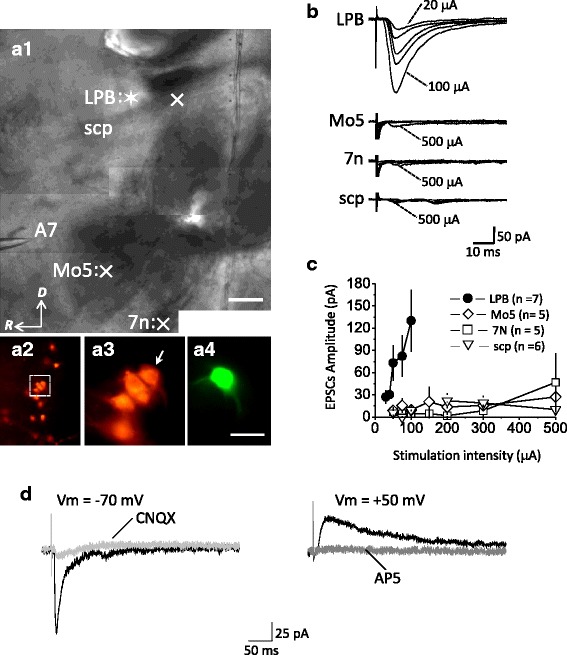Fig. 3.

LPB-A7 EPSCs. a. Photographs of a Nomaskic image of a living saggital brainstem slice for electrophysiology recording (A1) and of a fluorescent image of post hoc immunostaining after recording (A2–A3). The asterisk marks the position of extracellular stimulation of the LPB and symbols × mark the positions of stimulation of the scp: superior cerebellar peduncle (n = 5), Mo5: trigeminal motor nucleus (Mo5) and 7n: the 7th (A1). A cluster of TH-ir neurons (A2, A3) was identified in A7: A7 catecholamine cell group (see glass pipette in A1), which was ~ 200 mm rostral to the anterior border of the Mo5. One of the TH-ir neurons (see arrow in A3) was recorded and filled with biocytin (A4). D: dorsal; R: rostral. b. Representative experiments show recording of EPSCs in NAergic A7 neurons responding to extracellular stimulation of the LPB (upper traces), Mo5 (middle upper traces), 7n (middle lower traces), and scp (bottom traces). c. Summarized results of the experiments shown in B. Note that, with a stimulating intensity < 100 μA, EPSCs were evoked only when the stimulating electrode was placed in the LPB. Parentheses indicate the number of experiments conducted for testing LPB (n = 7), Mo5 (n = 5), 7n (n = 50 and scp (n = 6) stimulation. d. Representative experiments show that LPB-A7 EPSCs were blocked by CNQX (Vm = -70 mV) and by AP5 (Vm = +50 mV). Scale bar = 250 μm (A1), 30 μm (A2–A4)
